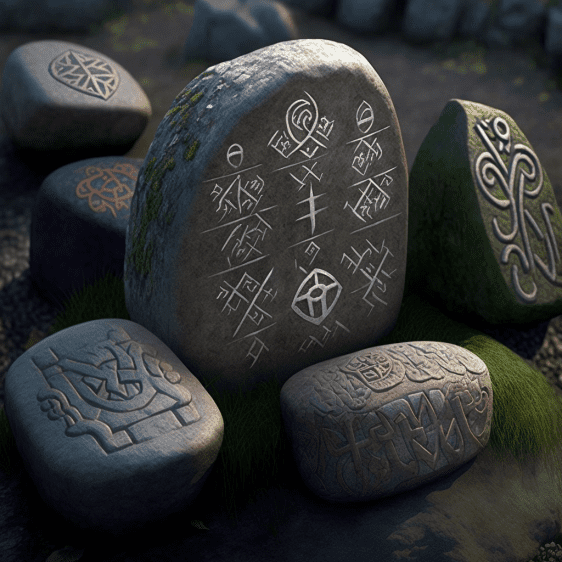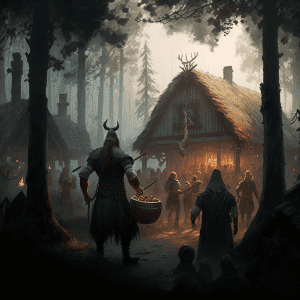What is Midvinterblot?
Midvinterblot, also known as the Midwinter Sacrifice, was an ancient pagan Scandinavian holiday that was celebrated during the mid-winter (around the winter solstice). It was a time of feasting and sacrifice. The celebration allowed people to reaffirm their faith in their Norse gods and ancestors. According to historical accounts, many believed that performing these sacrifices were essential for ensuring good luck for the following year.
The traditional practices of Midvinterblot included making offerings and sacrifices to the Norse gods. These could be animals such as goats or cows, and sometimes even humans were sacrificed. Offerings would also be placed on a bonfire or given to family or friends as good luck charms. After the offerings had been made, participants would come together and feast on whatever food had been brought in honor of the gods.
Dancing and music were also a significant part of this holiday celebration, with records indicating that it often went on through most of the night before coming to a close just before dawn. Afterward prayers were said for prosperity in the coming year, signaling an end to festivities.
Midvinterblot was an important part of Nordic winter holidays up until Christianity became more prevalent throughout Scandinavia during medieval times and eventually replaced it with Christmas celebrations and other Christian traditions instead.
The History of Midvinterblot How and When Did it Originate?
Midvinterblot, or Midwinter Sacrifice, was a Nordic holiday celebrating the longest night of the year. It was a blend of Scandinavian traditions and worshipping Odin. Originally, it was held on midwinter (December 21st according to the Julian calendar; around December 25th according to the Gregorian calendar.)
The celebration also had strong ties to sacrifice and bloodletting. During this holiday, Nordic people would make offerings to their gods in order to receive blessings or increase luck. We know from surviving folklore that animal sacrifice may have been part of Midvinterblot – especially goats! People believed these sacrifices helped appease their gods so he would bring good luck in agriculture, fishing and hunting for the coming year.
Midvinterblot was also linked with Yule – an old Germanic festival. People celebrated by dancing around bonfires and singing songs meant to honor Odin and other Viking gods. This was also a time for feasting and drinking mead, as well as gathering together family and exchanging gifts with loved ones. The tradition gradually disappeared as Christianity became more widespread in Europe during the Middle Ages but some local Swedish customs reviving elements of Midvinterblot can still be found today in some places!

Significance of Midvinterblot in Norse Mythology
Midvinterblot was an important holiday in Norse Mythology, celebrated during the midwinter season. The Midvinterblot festival is a celebration of death and renewal, and serves to honor the gods of Ragnarok. During this celebration, people would gather in sacred places such as groves, streams and on hilltops to give praise and offerings to Odin, Thor and other deities. The traditional Midvinterblot activities included animal sacrifice, feasting and drinks served from the calendar monument, or blótstula. Those who could afford it would then donate large amounts of food to their local temple or church.
The ritual held at Midvinterblot was believed to be essential in keeping the world alive by putting all energy into fertilizing Mother Earth , so that she could bloom again after winter passed The importance of fertility further emphasized by both men and women participating in dancing rituals around a big bonfire on location honouring Freya’s power over fertility. The sacrifices made at Midwinter were also meant to symbolically restore life balance and bring individuals closer with their gods. In addition, Frigga was said to weave golden records commemorating those names remembered on Midvinterblot eve with new aspects of mind opening up for consciousness related understanding . As a result people being aware that self-exploration leads to learning about themselves whilst incorporating becoming one with All That Is.
Celebrations of Midvinterblot and its Impact Over Time
Midvinterblot is an ancient Nordic holiday celebration that dates back to the pre-Christian era. It is celebrated around mid-winter, and is a ceremony primarily focused on honoring the God Odin and other gods of Norse mythology. This holiday was recognized in Sweden, Norway, Denmark, Iceland and Finland up until Christianization.
During Midvinterblot, offerings such as animals and food are made to the gods through ritualistic bonfires. It is believed this tradition served to strengthen connections between gods and humans as well as prayer for good fortune or success in upcoming hunting seasons. Additionally, it was also used as a way for communities to come together during the winter months, which often meant harsher temperatures and a lack of fresh food.
Over time, churches saw this pagan practice as a threat to their belief systems; therefore outlawed it across Europe, including Northamptonshire in England. In more recent years however there has been a growing effort from Scandinavian countries to revive certain aspects of Midvinterblot including the lighting of fires within special realms such as forests or parks throughout Scandinavia during midwinter to provide modern-day recognition of these significant ceremonies with participant’s safe distance maintained due to Covid-19 regulations in some instances differing regionally.
Additionally an increasing number of organizations have sought out ways to honor Midvinterblot even amidst global restrictions by hosting workshops which allow people to create altars honouring specific gods while deepening their understanding of Scandinavian folklore – such tutorials typically discussing origin stories, instructions on how to build makeshift alters where available and pertinent symbolism associated with deities featured during rituals typically practiced during Midvinterblast revivals

Rituals and Customs of Midvinterblot
Midvinterblot, or Midwinter-blood, was a pre-Christian Nordic winter holiday celebrated approximately in mid-January each year. This festival of Midwinter was a pagan celebration of the renewal of life and nature coming back from hibernation during the long winter months.
The festivities throughout Midvinterblot began in early January with bonfires to celebrate the death of winter and the impending return of spring. The main day for celebration, however, was on mid-January when it was believed that trolls had gone into hibernation for the remainder of their slumber. On this day, there were offerings made and sacrifices given for fertility, fortune and renewal in springtime. Pagan priests would also read prophecies about what the upcoming year held, while people would partake in feasting and dancing.
To honor the dead gods and goddesses of this time as well as celebrate rebirth after a harsh winter season, offerings such as grain and beer were made to appease the deities. There were animals sacrificed during this sacrifice ritual, which is why it became known as “Midvinterblot” or “midwinter blood” – depicting how much blood would be shed in travel to afterlife lands controlled by these gods themselves.. It is said that a feast followed where an ox would be slaughtered and eaten with vessels overflowing with mead – a fermented drink made from honey. The celebration ended with ringing bells followed by another bonfire at sunset to encourage growth that would bring spiritual prosperity to all communities before spring arrived.
Symbolism of Midvinterblot and its Role in Society
Midvinterblot was the original winter solstice celebration among the pre-Christian Nordic cultures. It was a time of thanksgiving and celebration, where farmers thanked the gods for the harvest they had received. This holiday also carried spiritual symbolism, as it marked the longest night of the year – darkness before light. Following Midvinterblot would have been Yule or Jul, which commemorates the return of light and hope after Midvinterblot’s darkness.
The specifics surrounding this holiday varied from culture to culture, but it typically involved sacrificing an animal in order to appease and plead with the gods. This ritual animal sacrifice took place under an ash tree, with grain set out on stone altars in order to call for luck for the new year. The meal afterwards included bread and butter drained in a wooden bowl to symbolize plenty and success during the coming months.
Midvinterblot served as a reminder to peasants of their connection with nature, especially during shorter days when livestock had difficulty feeding themselves. It brought people together as well – families came together around Midvinterblot’s communal fires, singing songs and sharing stories. Such gatherings were important for not only celebrating but for exchanging news about recent events within their community, further connecting people and reminding them that they all share similar struggles even in times of hardship.

Cultural Expectations Surrounding Midvinterblot
Midvinterblot was a Nordic winter holiday that celebrated around the dates of either December 20 or 21 in some cultures and Jan 12 or 13 in others. During the festivities, offerings were made to the Norse Gods and Goddesses of fertility and prosperity to ensure those values continued into the following year. Offerings usually included goats, ale, and sacrifices, such as animals or human blood. Sacrifices were accompanied by chanting and prayers to honor the deities as well as gatherings around bonfires to give thanks.
Other cultural expectations surrounding Midvinterblot included celebrating traditions like caroling and feasting. Carolers would often dress up in medieval style clothing and sing traditional winter ballads meant to bring joy during a lengthy season of darkness. Along with this custom came a feast for all in attendance that featured copious amounts of breads, cheeses, potatoes, boiled fish dishes, cider & drinks that had been aged throughout summer months aged with honey and spices. Many times people also exchanged gifts or tokens with one another to help spread cheer amongst friends and family alike. Taking part in various pagan rituals on this day was also encouraged as it was thought to keep away any bad spirits hoping to ruin what could be considered one of the most important days of celebration for Nordic pagans.
Conclusion Modern Day Meaning of Midvinterblot
Midvinterblot, which literally translates to “mid-winter sacrifice,” was the original Nordic winter holiday celebrated by the pre-Christian Scandinavian people. The main purpose of Midvinterblot was to give thanks for a successful harvest, provide protection against longer and darker nights, and welcome the arrival of spring.
Throughout the centuries, Midvinterblot evolved over time into a variety of other holidays such as Yule and Christmas. While certain elements remain similar between these celebrations – songs, traditions, symbols – in modern times Midvinterblot is largely seen as an obscure holiday from a bygone era.
To honor its past significance, many individuals today celebrate Midvinterblot as an opportunity to commemorate and acknowledge seasonal change away from the materialism associated with Christmas and the Christian tradition. For some practitioners this involves small rituals such as making offerings to Nature or sending out well wishes for family members far away during the long winter months. For others it may include larger gatherings such as potluck dinners or concerts that emphasize sharing stories, community connection, and appreciation for all aspects of life. No matter how one celebrates Midvinterblot today, its true meaning lies in taking a moment to reflect on our own lives and thank those who remain part of them now and throughout each new year’s journey.




